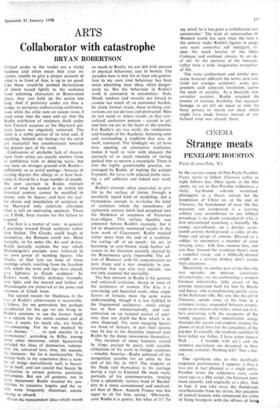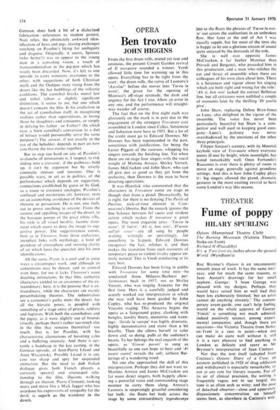CINEMA
Strange meats
PENELOPE HOUSTON
Pigsty (Cameo Poly, 'X') In the curious canon of Pier-Paolo Pasolini, Pigsty seems to follow Theorem rather as night follows day. Once again, as the film opens, we are in that Pasolini wilderness, a shaly, fog-bound volcanic wasteland, photogenic as a threat, terrain for the temptation of Christ or, at the end of Theorem, the banishment of man. On this occasion, our companion is a starving solitary (any resemblance to any biblical personage is no doubt coincidental) who is first encountered munching a butterfly. He comes, marvellously, on a derelict seven- teenth century battleground, a valley of dry bones and scraps of armour. Dressed as a soldier, he encounters a member of some straying army: kills him, mourns him, and eats him. Around the wanderer there's soon a cannibal troop; and a biblically-dressed couple on a passing donkey don't escape their attentions ...
Meanwhile, in another part of the film (the two episodes are intercut, sometimes devastatingly), we are confronting a modern German industrialist, fully aware of the porcine reputation built for him by Brecht and Grosz, who is machinating quietly away in his Italianate villa. His son, like the girl in Theorem, spends some of his time in a catatonic trance, suspended between tempta- tions to revolution and riches; when out of it, he's consorting with the occupants of the family piggery. Rival industrialists merge discreditable secrets and empires, trading the ghosts of dead Jews for the actualities of the pig-pen. Eventually, the exultant cannibal CI have killed my father. I have eaten human flesh . . . I tremble with joy') and the secretive pig-fancier are devoured, in their separate centuries. Nothing left? 'Not a but- ton ...'
One significant clue to this dazzlingly enigmatic performance, I suppose, is that it was not in fact planned as a single entity. Pasolini wrote the wilderness story some years ago as a film script; the German story more recently, and originally as a play. And in fact, if you take away the thunderous reverberations from the desert, this anecdote of cynical tycoons who compound the crime of being bourgeois with the offence of being
German, does look a bit of a dialectical fabrication—references to student protest, Nazi relics, the obstinately awkward iden- tification of Jews and pigs, teasing exchanges touching on Pasolini's liking for ambiguity and disguise. Originally, it seems, Spinoza (who better?) was to appear to the young man in a consoling vision, a touch of transcendentalism in the pig-pen which has wisely been discarded. Now, it's left to one episode to carry minatory overtones to the other, with suggestions of both Christian myth and the Oedipus story rising from the desert like the hot bubblings of the volcanic cauldrons. The cannibal breaks moral law and tribal taboo—a slightly significant distinction, it seems to me, but one which doesn't concern the film. Is his exultation in the act of cannibalism itself, in recognising realities rather than superstitions, in loving those he slaughters and consumes, or simply in defying his father—or Father? (In which case, a born cannibal's conversion to a diet of lettuce would presumably serve the same purpose?) The answer, if not exactly in the eye of the beholder, depends in part on how you rhyme the two stories together.
But to step too hard on any of Pasolini's avalanche of intimations is. I suspect, to risk sliding into a crevasse: if the pathways hold up, it isn't by argument but by strictly cinematic stresses and tensions. One is possibly wary, in art as in politics, of the performance which depends on suggestion, connections established by guess or by God, as a route to extremist analogies. Pasolini's confused and mysterious art, however, rests on an astonishing avoidance of the devices of rhetoric or persuasion. He is not, one feels, out to prove anything to anyone. From the austere and appalling images of the desert, to the baroque pomps of the great white villa, his style is all visual lucidity, laconic state- ment which seems to deny the image its sug- gestive power. The suggestiveness comes, here as in Theorem, from those audacious, inexplicit links with mythology, a kind of grandeur of atmosphere and seeming clarity of air which lures the spectator into his own identifications.
All the same. Pigsty is a cool and in some ways a circumspect work, and although its contentions may be denser, and its control even finer, for me it lacks Theorem's more dazzling intimations. In that film, authentic
characters yielded to an awareness of the ex- traordinary; here, it is the premise that is ex- traordinary, while the characters are mainly perambulating theories. The industrialists are a cartoonist's guilty men; the desert. for all the hieratic poses, is peopled with something of a stage army of priests, soldiers and fugitives. With both the cannibalism and the pigsty, as it were, slightly out of bounds visually, perhaps there's rather too mush else in the film that remains theoretical—too much, that is, for Pasolini, with his characteristic alternations of hovering calm and a buffeting intensity. And there is cer- tainly a handicap in the key casting, in the German episode, of Jean-Pierre Ldaud and Anne Wiazemsky. Possibly Laud is in any case too sharp and spry for suspended animation. But the need to dub Italian dialogue gives both French players a curiously spectral and attenuated rela- tionship to the film, illusions walking through an illusion. Pierre Clementi, looking more and more like a Mick Jagger who has overdone his expressions of sympathy for the devil, is superb as the wanderer in the desert.



































 Previous page
Previous page